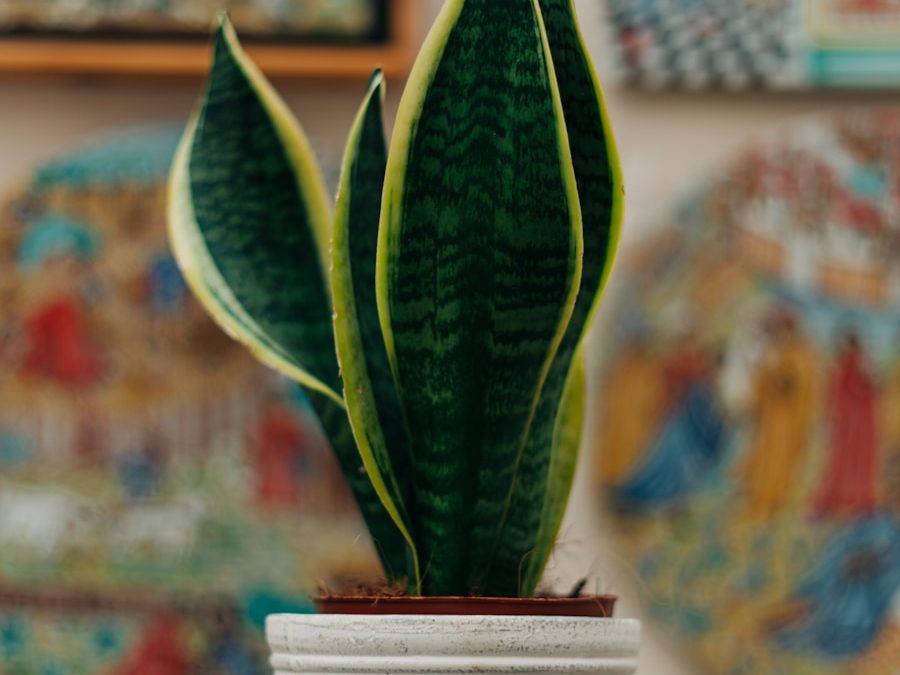Indoor plants have become a staple in home décor, bringing a touch of nature indoors. However, not all spaces in our homes are blessed with abundant sunlight, making it challenging to keep traditional houseplants alive. Fortunately, there are several unusual indoor plants that not only survive but thrive in low-light conditions. These plants are not just hardy but also add a unique aesthetic appeal to your home, making them perfect for those dim corners that could use a little greenery.
Contents
- 1 1. Snake Plant (Sansevieria trifasciata)
- 2 2. ZZ Plant (Zamioculcas zamiifolia)
- 3 3. Cast Iron Plant (Aspidistra elatior)
- 4 4. Chinese Evergreen (Aglaonema)
- 5 5. Monstera Adansonii (Swiss Cheese Plant)
- 6 6. Peacock Plant (Calathea makoyana)
- 7 7. Pothos (Epipremnum aureum)
- 8 8. Lucky Bamboo (Dracaena sanderiana)
- 9 9. Maidenhair Fern (Adiantum)
- 10 10. Prayer Plant (Maranta leuconeura)
- 11 Conclusion
1. Snake Plant (Sansevieria trifasciata)
The Snake Plant, also known as the Mother-in-Law’s Tongue, is a popular choice for low-light environments. Its striking, sword-like leaves grow upright, and it’s incredibly easy to care for, making it a favorite among plant enthusiasts.
Why It Thrives in Low Light
Snake Plants are native to West Africa, where they typically grow under the shade of other plants. This makes them highly adaptable to low-light conditions. They have a unique ability to perform photosynthesis at night, which allows them to convert carbon dioxide into oxygen even in low light.
Care Tips
- Watering: Allow the soil to dry out completely between waterings. Overwatering can lead to root rot.
- Soil: Well-draining soil is crucial. A cactus or succulent mix works well.
- Placement: While they can tolerate low light, they do best with indirect light. A few feet away from a window is ideal.
The Snake Plant is also known for its air-purifying qualities, making it not just a beautiful addition to your home but a functional one as well.
2. ZZ Plant (Zamioculcas zamiifolia)
The ZZ Plant is another resilient plant that can thrive in low-light conditions. Its shiny, dark green leaves have a unique waxy coating, giving it a striking appearance that can brighten up any dim space.
Why It Thrives in Low Light
ZZ Plants are native to the forests of Eastern Africa, where they grow under the canopy of larger trees. This natural habitat has made them incredibly tolerant of low light, as they’ve adapted to survive with minimal sunlight.
Care Tips
- Watering: The ZZ Plant is drought-tolerant. Water when the top inch of soil is dry.
- Soil: Use well-draining potting soil. A standard indoor potting mix will suffice.
- Placement: It can thrive in low-light areas, but avoid direct sunlight as it can scorch the leaves.
The ZZ Plant is also known for being one of the easiest houseplants to care for, making it an excellent choice for beginners or those with a busy lifestyle.
3. Cast Iron Plant (Aspidistra elatior)
As its name suggests, the Cast Iron Plant is incredibly tough and can withstand neglect, making it perfect for low-light environments. With its broad, dark green leaves, it adds a touch of elegance to any room.
Why It Thrives in Low Light
Native to the forest floors of Japan and Taiwan, the Cast Iron Plant naturally grows in shaded areas with little light. It has evolved to thrive in these conditions, making it an excellent choice for spaces with minimal natural light.
Care Tips
- Watering: Water when the soil feels dry to the touch. It’s better to underwater than overwater this plant.
- Soil: Use a well-draining, loamy soil mix.
- Placement: It can tolerate low light but will also do well in indirect light. Keep it away from direct sunlight.
The Cast Iron Plant is also known for its longevity, often living for decades with minimal care, making it a long-term investment for your home décor.
4. Chinese Evergreen (Aglaonema)
The Chinese Evergreen is a versatile plant known for its stunning foliage, which comes in a variety of colors and patterns. It’s one of the most popular houseplants due to its low maintenance needs and ability to thrive in low-light conditions.
Why It Thrives in Low Light
Chinese Evergreens are native to the tropical and subtropical regions of Asia, where they grow on the forest floor under the dense canopy. This has made them highly adaptable to low-light environments, as they’ve evolved to survive with limited sunlight.
Care Tips
- Watering: Keep the soil consistently moist but not soggy. Allow the top inch of soil to dry out between waterings.
- Soil: A well-draining potting mix with some peat moss is ideal.
- Placement: It prefers low to medium light and should be kept out of direct sunlight.
One of the key attractions of the Chinese Evergreen is its ability to purify the air, making it both a decorative and functional plant for indoor spaces.
5. Monstera Adansonii (Swiss Cheese Plant)
The Monstera Adansonii, also known as the Swiss Cheese Plant due to its unique perforated leaves, is a trendy choice for indoor plant enthusiasts. While it’s often associated with bright light, it can also thrive in low-light conditions.
Why It Thrives in Low Light
Monstera Adansonii is native to the tropical rainforests of Central and South America, where it grows in the shade of taller trees. This makes it well-suited to lower light conditions, as it’s accustomed to filtering light through the forest canopy.
Care Tips
- Watering: Water when the top inch of soil is dry. Ensure the plant is in a pot with good drainage to prevent waterlogging.
- Soil: A mix of peat-based potting soil and perlite works well.
- Placement: It prefers indirect light but can tolerate lower light levels. Avoid direct sunlight, which can scorch the leaves.
The Monstera Adansonii not only adds a tropical vibe to your space but also serves as a conversation starter due to its distinctive leaf pattern.
6. Peacock Plant (Calathea makoyana)
The Peacock Plant is known for its striking foliage, featuring intricate patterns that resemble the tail feathers of a peacock. It’s a stunning plant that can thrive in low-light conditions, adding a touch of color and elegance to any room.
Why It Thrives in Low Light
The Peacock Plant is native to the understory of tropical rainforests in Brazil, where it grows in shaded environments. Its natural habitat has made it well-suited to low-light conditions, where it can thrive without direct sunlight.
Care Tips
- Watering: Keep the soil consistently moist but not waterlogged. Use filtered or distilled water to avoid the leaf tips browning.
- Soil: A well-draining potting mix with added peat moss is ideal.
- Placement: It prefers low to medium light and high humidity. Avoid placing it in direct sunlight.
The Peacock Plant is a bit more demanding in terms of humidity and watering, but its stunning appearance makes it well worth the extra effort.
7. Pothos (Epipremnum aureum)
Pothos, also known as Devil’s Ivy, is one of the most popular indoor plants for beginners. Its trailing vines and heart-shaped leaves make it a versatile plant that can be grown in hanging baskets or as a climbing plant.
Why It Thrives in Low Light
Pothos is native to the Solomon Islands in the South Pacific, where it grows in the shaded understory of forests. This makes it highly adaptable to low-light conditions, where it can continue to grow and even flourish.
Care Tips
- Watering: Water when the top inch of soil is dry. Pothos is very forgiving if you forget to water it occasionally.
- Soil: Use a well-draining potting mix. It’s not particularly fussy about soil types.
- Placement: Pothos can thrive in low light but will also do well in indirect light. Avoid direct sunlight.
Pothos is also known for its air-purifying qualities, making it an excellent choice for any indoor space, especially in rooms where you spend a lot of time.
8. Lucky Bamboo (Dracaena sanderiana)
Despite its name, Lucky Bamboo is not actually bamboo but belongs to the Dracaena family. It’s a popular plant in Feng Shui and is believed to bring good luck and positive energy into the home.
Why It Thrives in Low Light
Lucky Bamboo is native to the rainforests of Central Africa, where it grows under the canopy in low-light conditions. This makes it highly adaptable to indoor environments with minimal natural light.
Care Tips
- Watering: Lucky Bamboo is typically grown in water rather than soil. Ensure the roots are submerged in water and change the water every two weeks.
- Soil: If growing in soil, use a well-draining potting mix and keep the soil moist.
- Placement: It prefers low to moderate light and should be kept out of direct sunlight.
Lucky Bamboo is not only easy to care for but also adds a touch of elegance and tranquility to your space, making it a popular choice for offices and homes alike.
9. Maidenhair Fern (Adiantum)
The Maidenhair Fern is a delicate and graceful plant with lacy, bright green fronds. It’s known for its beauty and the ability to thrive in low-light conditions, making it a favorite among indoor gardeners.
Why It Thrives in Low Light
The Maidenhair Fern is native to the shaded, moist environments of forests and creeksides. Its natural habitat has made it highly tolerant of low light, where it can continue to grow and maintain its vibrant color.
Care Tips
- Watering: Keep the soil consistently moist. This plant does not tolerate drying out.
- Soil: Use a rich, well-draining potting mix with added organic matter.
- Placement: It prefers low to medium light and high humidity. Keep it away from direct sunlight, which can cause the fronds to scorch.
The Maidenhair Fern is slightly more demanding in terms of humidity and watering, but its delicate appearance and lush growth make it a stunning addition to any indoor space.
10. Prayer Plant (Maranta leuconeura)
The Prayer Plant is named for its unique habit of folding its leaves up at night, resembling hands in prayer. It’s a visually striking plant with variegated leaves that can thrive in low-light conditions.
Why It Thrives in Low Light
The Prayer Plant is native to the tropical forests of Brazil, where it grows under the dense canopy of trees. This environment has made it well-suited to low-light conditions, where it can continue to thrive without direct sunlight.
Care Tips
- Watering: Keep the soil consistently moist but not waterlogged. Use lukewarm water to avoid shocking the plant.
- Soil: A well-draining potting mix with added peat moss is ideal.
- Placement: It prefers low to medium light and high humidity. Avoid placing it in direct sunlight.
The Prayer Plant’s unique appearance and low-light tolerance make it an excellent choice for adding a touch of nature to your indoor space.
Conclusion
When it comes to indoor gardening, low light doesn’t have to be a limitation. These unusual indoor plants not only thrive in low-light conditions but also bring unique textures, colors, and shapes to your home. Whether you’re a beginner or a seasoned plant parent, these plants offer an opportunity to enhance your living space with greenery, even in the dimmest corners.


